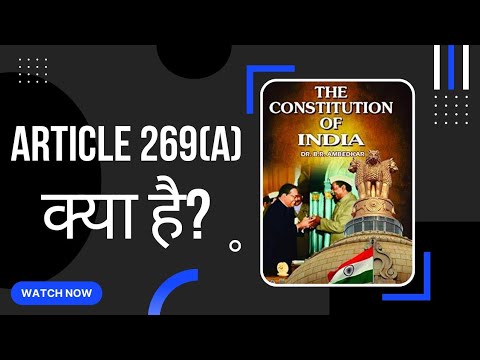Key Takeaways
- Unified Tax Framework: Article 269A establishes a harmonized structure for the levy and collection of GST on inter-state supplies of goods and services, thereby simplifying the tax landscape across India and promoting a unified national market.
- Destination-Based Taxation: This article ensures that GST is a destination-based tax, meaning that the tax revenue is accrued to the state where the goods or services are ultimately consumed, aligning tax revenue with consumption rather than production.
- Input Tax Credit Mechanism: Article 269A facilitates a seamless flow of input tax credits across state lines, preventing the cascading effect of taxes (tax on tax) and promoting economic efficiency by reducing the overall tax burden on businesses and consumers.
- Role of GST Council: Article 279A, established under the 101st Amendment, highlights the role of the GST Council, which is crucial in governing GST implementation, including rates, exemptions, and special provisions, ensuring coordinated tax policy and administration across states.
The Constitution (101st Amendment) Act, 2016, is a significant reform in the Indian tax system that introduced the Goods and Services Tax (GST). Here’s a detailed overview of how the amendment to the article reshaped the constitution to facilitate the GST, including its types, specific cases, and the power to legislate for interstate goods.
Types of GST
GST in India is categorized into three types:
- CGST (Central Goods and Service Tax): Levied by the Central Government on intra-state sales (within the same state).
- SGST (State Goods and Services Tax): Levied by the State Government on intra-state sales.
- IGST (Integrated Goods and Services Tax): Levied by the Central Government for inter-state sales (between two states).
- Case of Interstate GST (IGST)
IGST is designed to ensure that states where goods are consumed receive the tax revenue from their sale. This eliminates the earlier tax-on-tax structure that was prevalent in the pre-GST regime, promoting a more unified market across the country.
Below is breakdown of how IGST functions and its implications
How Does IGST Work?
- Mechanism: IGST is levied on inter-state supplies of goods and services. The central government collects it and then distributes it between the originating and destination states. The IGST rate is generally equal to the sum of the central GST (CGST) and state GST (SGST) rates.
- Flow of Credit: One of the main features of IGST is the free flow of input tax credits from one state to another. A dealer purchasing goods from another state pays IGST on the transaction, which can be used as a credit against IGST, CGST, or SGST liabilities on subsequent sales.
- Zero-Rated Supply: Exports and supplies to Special Economic Zones (SEZs) are treated as zero-rated, meaning that no tax is actually paid on such transactions, but credit for input taxes paid can be claimed. This promotes exports by not taxing export revenues while still allowing taxation on inputs used to produce those goods or services.
Case of Input Credit (Article 269A(3) and (4))
Article 269A(3) and (4) of the Indian Constitution ensure that the credit of input tax can be availed for the payment of GST on the supply of services and goods. This is intended to make the entire value chain in the supply of goods and services tax-neutral, irrespective of the location of consumption.

Provisions of Article 269A(3) and (4)
- Article 269A(3): This provision stipulates that the Government of India may, by law, on the recommendation of the GST Council, provide for specific guidelines regarding the place of supply of goods and services in the context of inter-state trade or commerce. This is crucial for determining where the taxes should be collected and who gets the revenue, particularly in complex supply scenarios like services that are delivered digitally or goods that are assembled in multiple states.
- Article 269A(4): This subsection focuses on ensuring that the input tax credit is available in the state where the goods or services are ultimately consumed. This is essential to making the GST a destination-based tax. The provisions with respect to this article ensure that the tax revenue accrues to the consuming state even though the tax may have been collected in another state at the point of origin.
Power to Make GST Law for Inter-state Goods
The power to make laws governing the Goods and Services Tax (GST), especially concerning inter-state transactions, is an integral part of India’s federal structure and its tax regime.

The Constitution (101st Amendment) Act, 2016, specifically restructured the legislative competence between the Union and the states to implement GST, which included the introduction of the Integrated Goods and Services Tax (IGST) for inter-state supplies.
Constitutional Provisions
The 101st Amendment’s introduction of Article 246A of the Indian Constitution is crucial to the GST legislative framework. It confers simultaneous powers on both Parliament and state legislatures to make laws governing GST. However, for inter-state transactions, the specific powers are allocated as follows:
- Exclusive Power of Parliament: Article 246A specifies that only Parliament has the exclusive power to legislate on matters of GST where the supply of goods or services or both occurs across state boundaries, i.e., inter-state supplies. This exclusive power includes the competitive authority to formulate laws on IGST, which applies to:
- Supplies of goods and services from one state to another.
- Supplies involving exports and import transactions.
- Supplies to and from Union Territories.
- Article 269A: This article underpins the levy and collection of interstate trade on all interstate supplies of goods and services and specifies that such GST will be levied and collected by the Government of India but divided between the Union and the states in the manner prescribed by law based on the recommendations of the GST Council.
Role of the GST Council
The GST Council, established under Article 279A, plays a pivotal role in the governance of GST, including IGST. The Council is a joint forum of the Centre and the states, and it makes recommendations on various issues related to GST, such as:
- Rates
- Exemptions
- Threshold limits
- Special provisions for certain states, etc.
The GST Council’s recommendations ensure that there is uniformity in GST laws across the country, including those related to inter-state commerce.
Implications of Parliamentary Power
- Uniformity: The central legislation of IGST helps maintain uniform tax rates across different states, thereby simplifying the tax structure and making it easier for business compliance.
- Reduced Complexity: By having a single authority (Parliament) legislate the tax regime for inter-state trade, the complexities involved in dealing with multiple state laws and varying tax rates are significantly reduced.
- Efficiency and Clarity: It provides clarity and predictability to businesses operating across state boundaries, which is essential for strategic planning and operational efficiency.
List of Amendments Relevant to GST
- Article 246A: Grants both the Parliament and state legislatures the power to make laws with respect to GST. However, only Parliament can legislate inter-state GST.
- Article 269A: Deals with the levy and collection of GST for inter-state supply, which is vested in the hands of the central government, with revenue shared between the center and the states.
- Article 279A: Establishes the GST Council, which functions as a constitutional body that makes recommendations to the Union and state governments on issues related to GST.
- Article 286: Restricts states from tax imposition on supplies outside the state or in the course of import into or export out of the territory of India.
- Article 366: Introduces key definitions within the context of GST, providing clarity and uniformity in interpretation across the states.
What is Article 269A GST?
The Constitution (101st Amendment) Act, 2016, which established Article 269A of the Indian Constitution, is the cornerstone for the imposition and collection of GST on the supply of goods and services in interstate trade.
This provision plays a significant role in defining how taxes are applied to various products and services across state lines, ensuring that the tax system is harmonious, equitable, and conducive to a unified national market.
Let’s explore how Article 269A interacts with the concept of ‘tax on supply’ and relates to various elements within the GST framework.
Main Provisions of Article 269A
- Levy of GST on Inter-state Supplies: According to Article 269A(1), the Government of India must levy and collect GST on the supply of goods or services, or both, when the transaction crosses state boundaries. The Union and the states will then split the tax according to the law that Parliament has created. This is primarily done through the IGST (Integrated Goods and Services Tax).
- Determination of Place of Supply: Under Article 269A(3), it is detailed that the place of supply shall determine whether a supply is inter-state or intra-state. This is crucial for deciding which type of GST (IGST, CGST, or SGST) is applicable. The rules regarding the place of supply help in determining the tax jurisdiction and ensuring that the tax revenue accrues to the state where the goods or services are ultimately consumed.
- Input Tax Credit for IGST: Article 269A(4) facilitates the seamless flow of input tax credit for IGST across state lines. This provision ensures that the credit can be availed in the state where the goods or services are consumed, thereby maintaining the integrity of GST as a destination-based tax.
- Zero-rated Supplies: The article also supports the concept of zero-rated supplies, where exports and transactions with Special Economic Zones (SEZs) are not taxed under GST but allow for the claim of input tax credits. This is intended to boost India’s export activities by relieving exporters from the GST burden while allowing them to recover the costs associated with the production of exported goods through input tax credits.
Guidelines and Rules:

The GST Council makes recommendations for the procedural details and regulations that underpin the application of Article 269A, and Parliament enacts those regulations through legislation. These include the specifics of tax rates, place of supply rules, and the mechanism for the collection and distribution of taxes.
- Article 269A and ‘Tax on Supply’: Under Article 269A, GST is levied on every supply of goods or services, except for those which are exempt. The term ‘supply’ is broadly defined and includes all forms of supply made for consideration in the course of business. The main points include:
- Inter-State Supply: GST on supplies that cross state boundaries is specifically addressed through IGST (Integrated Goods and Services Tax), which is designed to be collected by the central government but shared between the originating and destination states.
- Input Tax Credit: This feature allows businesses to claim credit for the tax they’ve paid on their inputs, which helps avoid the cascading effect of taxes—tax being paid on a tax already paid.
Special Rate Categories and Floor Rates
Certain goods and services, such as tobacco products, alcoholic liquor, and petroleum crude, are subject to ‘Special Rates’ under GST. These rates may be higher than standard GST rates due to the nature of the products and their consumption externalities.
- Floor Rates with Bands: To prevent significant variations in tax rates applied across states and to maintain a standard level of revenue from GST, floor rates and rate bands are sometimes discussed. These ensure that states do not undercut each other but maintain a uniform tax structure.
Application to Specific Goods
- Tobacco Products and Alcoholic Liquor: These items are often taxed at higher rates because of their health implications. Despite GST, states retain the power to levy taxes on the sale of alcohol due to its exclusion from GST.
- Petroleum Products: Like alcohol, petroleum products such as petroleum crude and high-speed diesel are currently outside the ambit of GST, with states having the authority to impose varying rates of sales tax/VAT.
Handling Exceptions
- Natural Calamities: In the event of a natural calamity, GST rates or rules may be adjusted temporarily to provide relief to affected areas, often at the discretion of the GST Council.
- Procedural Irregularities: Provisions are in place under the GST laws to handle procedural irregularities, ensuring that penalties are reasonable and do not unduly burden businesses.
Implications of Article 269A
- Revenue Sharing: Article 269A provides a clear mechanism for the sharing of tax revenues between the central and state governments, which is crucial for maintaining fiscal federalism in India.
- Reduction in Tax Evasion: By implementing the IGST and allowing for the seamless flow of input tax credits across state lines, the GST system under Article 269A helps in reducing tax evasion and ensuring transparency in the taxation system.
- Streamlining of Taxes: This article simplifies the tax structure for inter-state trade, replacing multiple taxes and cesses that were prevalent before GST. It helps create a more unified and integrated national market.
- Enhanced Compliance and Administration: With clear guidelines on tax levies and collections, Article 269A aids in better secretarial compliance and easier administration of taxes.

Article 269A thus plays a foundational role in the architecture of GST in India, aiming to enhance the efficiency of tax collection and reduce the complexity of the tax system in the country, promoting a common national market.
Compensation to States Under GST
To mitigate any revenue losses incurred by states due to the implementation of GST, the central government has committed to compensating states for a period of five years. This is especially relevant for states that were highly dependent on taxes from goods that are now under the uniform GST regime.
Impact of Article 269A on Inter-state Trade
Article 269A effectively harmonizes the tax structure across states, ensuring that the GST system works as intended—taxing consumption rather than production. By doing so, it not only simplifies the tax regime but also makes it fairer, with revenue going to the states where goods and services are consumed. This is especially important for states that are major consumption centers but have less industrial activity.
Conclusion
The GST reform through the Constitution (101st Amendment) Act, 2016, represents a transformative shift in Indian taxation policy aimed at creating a single, unified market within the country. By reducing the cascading effect of taxes and simplifying the tax structure, GST enhances compliance and increases revenue efficiency.
Article 269A is integral to understanding and implementing GST across India, particularly concerning the tax on the supply of various goods and services. It ensures that GST is levied in a manner that is fair, uniform, and considers the diverse economic landscape of the country. By detailing how inter-state supplies are to be taxed and providing a mechanism for the proper distribution of revenues, Article 269A helps maintain the delicate balance of fiscal federalism in India.
💡Forgetting to pay your GST on time? Pay your GST on time with the Pice business payment app using your credit card and enjoy rewarding benefits! Start now to make the most of your payments.
FAQs
How does IGST work?
IGST is charged on the value of inter-state transactions of goods and services, with the revenue shared between the central and state governments.
What is the role of the GST Council?
The GST Council guides the tax rate, tax exemption, the due date of forms, tax laws, and tax deadlines, ensuring uniformity of tax rates and structures and governance consistent across the country.
How are states compensated for revenue losses due to GST?
States are compensated for any potential losses through revenue collected under GST for the first five years of its implementation. This is calculated based on projected revenue growth of 14% per year from the base year of 2015–16.
What role does Article 269A play in the GST framework?
Article 269A is crucial as it outlines the principles for levy and collection of GST on inter-state supplies, ensuring a destination-based tax structure. It also facilitates the smooth flow of input tax credits across states, supporting the integrity and efficiency of the GST system.
Who governs the GST rates and exemptions?
The GST Council, established under Article 279A, governs GST rates, exemptions, and other related policies. It is a joint forum of the Centre and the states that ensures uniformity and harmonization across India through its recommendations.








